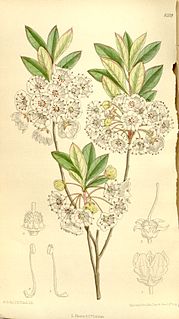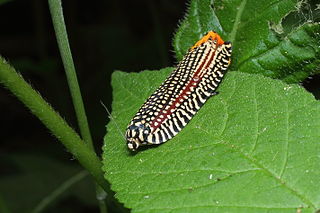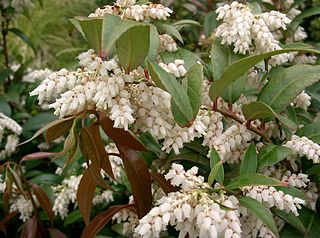The Louisiana quillwort is a small, grass-like aquatic plant of the family Isoetaceae. It is "one of the rarest quillworts in North America." It occurs in only five locations in St. Tammany and Washington Parishes of Louisiana and some spots in southern Mississippi. It is federally listed as an endangered species, partly due to its highly restricted range.

Florida sand pine scrub is an endangered subtropical forest ecoregion found throughout Florida in the United States. It is found on coastal and inland sand ridges and is characterized by an evergreen xeromorphic plant community dominated by shrubs and dwarf oaks. Because the low-nutrient sandy soils do not retain moisture, the ecosystem is effectively an arid one. Wildfires infrequently occur in the Florida scrub. Most of the annual rainfall falls in summer. It is endangered by residential, commercial and agricultural development, with the largest remaining block in and around the Ocala National Forest. Lake Wales Ridge National Wildlife Refuge also holds a high proportion of remaining scrub habitat, while the Archbold Biological Station near Lake Placid contains about 20 km2 (7.7 sq mi) of scrub habitat and sponsors biological research on it.

Poor Mountain Natural Area Preserve is a 933-acre (378 ha) Natural Area Preserve located on Poor Mountain in Roanoke County, Virginia. The preserve protects the world's largest population of piratebush, a globally rare parasitic shrub. The mountain derives its name from the fact that the soils on its slopes are poor, due to their base of metamorphosed sandstone bedrock. The preserve's pine-oak/heath woodlands include Table Mountain pine, eastern hemlock, several species of oak, and shrubs including huckleberry, mountain laurel, and fetterbush.
The Jardin botanique de Gondremer is a private botanical garden with national collections of rhododendrons and azaleas, kalmia, heathers, and Japanese maples, classified as a Jardin Remarquable by the French ministry of culture. It is located several kilometers east of Autrey and Housseras, Vosges, Grand Est, France, and open at specific periods suitable for the collections; an admission fee is charged.

Deeringothamnus pulchellus is a rare species of flowering plant in the custard apple family known by the common names beautiful pawpaw, royal false pawpaw, and white squirrel banana. It is endemic to Florida in the United States, where there are perhaps 5000 plants remaining in severely fragmented habitat in three counties. The main threat to this species is habitat destruction and degradation. It was federally listed as an endangered species in 1986.

Deeringothamnus rugelii is a rare species of flowering plant in the custard apple family known by the common names Rugel's pawpaw, Rugel's false pawpaw, and yellow squirrel banana. It is endemic to Volusia County, Florida, in the United States, where there are fewer than 5000 plants remaining in severely fragmented habitat. The main threat to this species is habitat destruction and degradation. It was federally listed as an endangered species in 1986.

Gaylussacia dumosa is a species of flowering plant in the heath family known by the common names dwarf huckleberry, bush huckleberry, and gopherberry. It is native to eastern North America from Newfoundland to Louisiana and Florida. It occurs along the coastal plain and in the mountains.

Eubotrys racemosa is a species of flowering plant in the heath family known by the common names fetterbush, swamp doghobble, and swamp sweetbells.

Lyonia lucida is a species of flowering plant in the heath family known by the common names fetterbush lyonia, hurrahbush, and staggerbush. Other plants may be called fetterbush. This broadleaved evergreen plant grows on the coastal plain of the southeastern United States from Virginia to Florida to Louisiana. It also occurs in Cuba.

Smilax laurifolia is a species of flowering plant in the greenbrier family known by the common names laurel greenbrier, laurelleaf greenbrier, bamboo vine, and blaspheme vine. It is native to the southeastern United States, where it occurs along the Gulf and Atlantic coastal plains from Texas to New Jersey, the range extending inland to Arkansas, Oklahoma, and Tennessee. It also occurs in Cuba and the Bahamas.

Kalmia cuneata is a species of flowering plant in the heath family known by the common name whitewicky, sometimes spelled white-wicky or white wicky. It is native to the eastern United States, where it occurs only in North Carolina and South Carolina.

The Southeastern conifer forests are a tropical and subtropical coniferous forest ecoregion of the southeastern United States. It is the largest conifer forest ecoregion east of the Mississippi River.

The Southern coastal plain nonriverine basin swamp is a wetland system found along the southern Atlantic coastal plain and the eastern Gulf coastal plain, and extending into the Florida peninsula. These wetlands occur in large, seasonally flooded depressions away from rivers. Sites are often forested by trees including bald cypress, swamp tupelo, evergreen shrubs, and hardwoods. Slash pine is sometimes found. Characteristic shrubs include buckwheat tree, swamp cyrilla, fetterbush lyonia, and laurelleaf greenbrier.
The southern coastal plain nonriverine cypress dome is a forested wetland community found in the southern Atlantic coastal plain, in the states of Alabama, Florida, Georgia, Louisiana, and Mississippi.
The east Gulf coastal plain near-coast pine flatwoods are forests and woodlands found in the eastern Gulf coastal plain, in the states of Alabama, Florida, Georgia, Louisiana, and Mississippi. They take the form of forests and woodlands on broad, sandy flatlands. Fires are naturally frequent, occurring every one to four years.

Cerace xanthocosma, the kaleidoscope moth, is a species of moth of the family Tortricidae. It is found in Russia, Japan and Taiwan.

Pieris floribunda is a North American species of broadleaf evergreen shrub, a member of the fetterbush genus in the blueberry family (Ericaceae). It is commonly known in North America as mountain fetterbush or mountain andromeda. All parts of Pieris floribunda are poisonous if ingested. It is a rare plant to find in landscapes because it is difficult to propagate and it often does not adapt well to cultivation. However, there are a few specialty and native plant nurseries that sell some, overcoming the more difficult propagation. In landscapes it should be grown in full to part shade, out of windy locations, and have a good quality soil with lots of organic matter that is acid of pH 4.5 to 6.5














